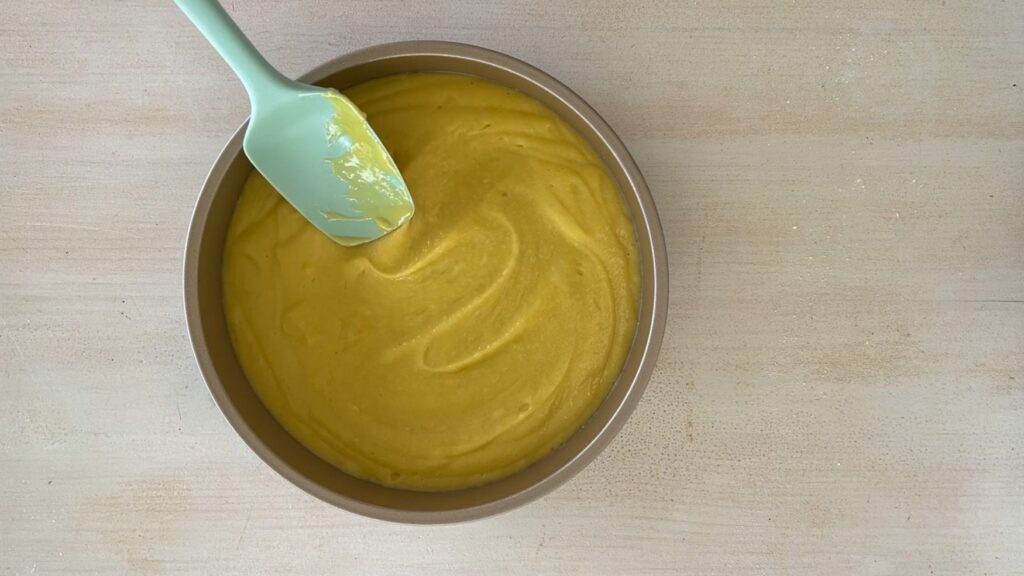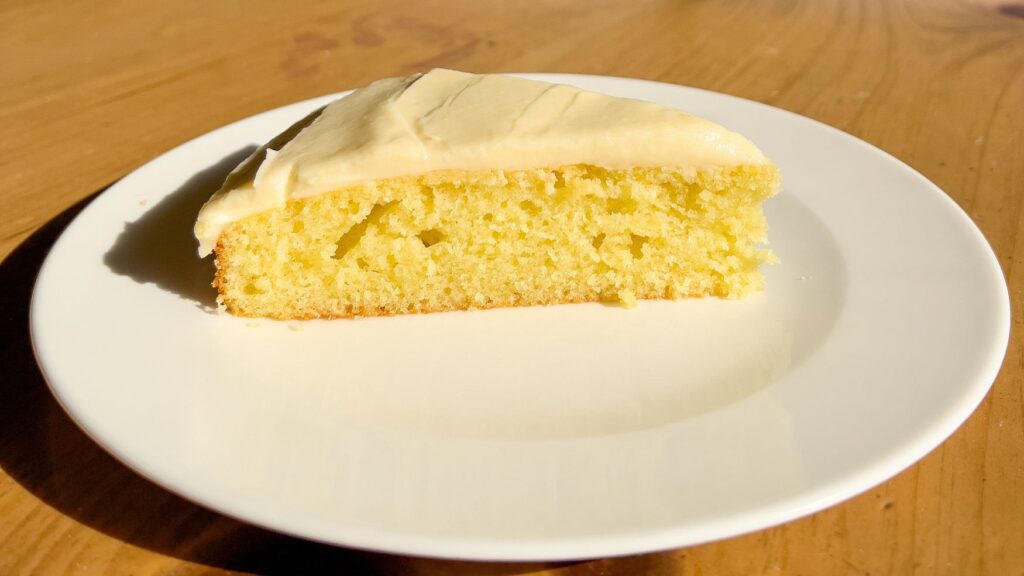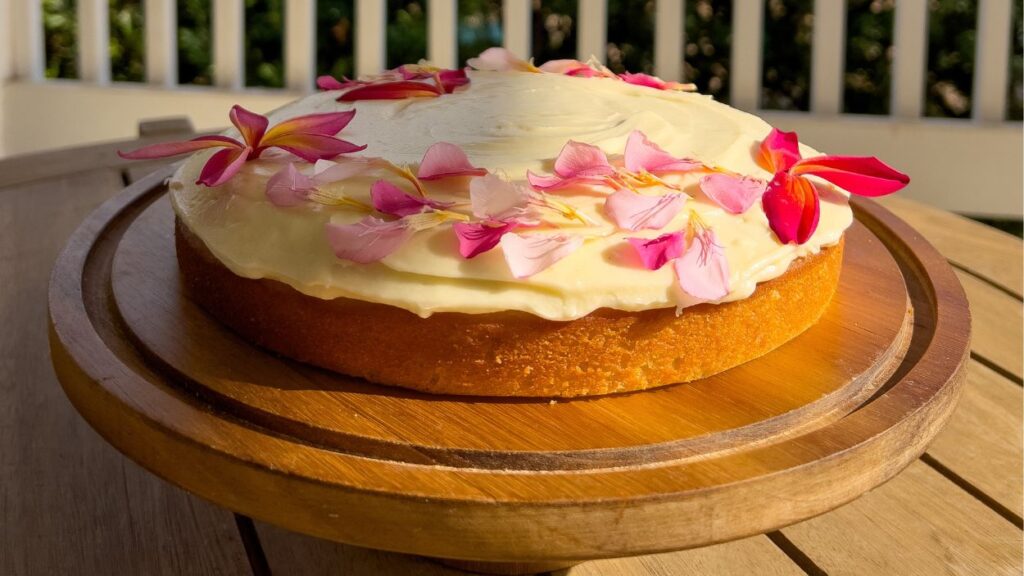This olive oil cake is the perfect way to elevate your typical vanilla or yellow birthday cake for a sophisticated celebration. It’s simple, so good, and fancy-ish. At least, it comes off as fancier than vanilla cake for some reason (probably because it makes me think of the Kardashians; see below). This is a perfectly balanced cake; it’s not too sweet, it has hints of citrus, it’s rich from the olive oil, and it has both brown butter and cream cheese frosting.
It’s also only a single layer cake, so it’s perfect for those with small or single households who can’t finish a typical double layer cake alone before it goes bad—although you can easily double the recipe to make it one. Read the bake notes to find out how I fashion up the leftovers to eat for breakfast.
What Does an Olive Oil Cake Taste Like?
Most olive oil cakes have hints of citrus, so they taste like super moist lemon or orange (or whatever the citrus used) cakes that aren’t overly sweet.
What Does Olive Oil Do to a Cake?
The high-fat content of olive oil helps keep cakes very soft and moist, making them pretty much foolproof! There’s very little chance of getting a dry cake with this recipe, so it can be attempted by anyone, even self-proclaimed non-bakers.

How Long Does It Last?
You can keep unfrosted olive oil cake wrapped in plastic on the counter for around 5 days. With frosting, it should be kept refrigerated and is best eaten within 3 days.
Why Is Olive Oil Cake So Popular?
Ultimately, olive oil cake is popular because it’s unique and really good. However, in 2020, Kylie Jenner told the internet it was her favorite kind of cake, so then it was everyone’s favorite cake—you know, as it goes.
Bake Notes
- To create a parchment paper round for the bottom of the cake pan, I trace the outline of the cake pan on a sheet of parchment paper and cut it out. I save the excess parchment paper to tuck under the edges of the cake when I put it on my plate/cake stand before I frost it; then, any frosting mess will fall onto the parchment and you can easily slide it out to keep your plate clean.
- Use olive oil to grease your cake pan instead of butter or cooking spray to keep the flavors cohesive.
- You can use any citrus in place of the orange juice—lemon, blood orange, grapefruit, or lime.
- Be careful not to burn your butter when you are browning it, but don’t be overly cautious and take it off too early—you’ll miss out on the caramelized flavor, which is the star of this frosting. Be confident! The whole process usually takes around 8 minutes on my stove at medium heat.
- You can choose how much powdered sugar to use in the icing based on how sweet you want it. I prefer to use 2 to 2 ½ cups. Taste the frosting after each cup of powdered sugar you add and see for yourself!
- Since this cake isn’t overly sweet, I love to eat it leftover for breakfast topped with hemp seeds and raspberries or blackberries. It has yogurt in it, so it’s acceptable.


Olive Oil Cake With Brown Butter Cream Cheese Frosting
- Total Time: 1 hour
- Yield: 6–8 servings 1x
Description
This olive oil cake is the perfect sophisticated twist to a basic vanilla birthday cake.
Ingredients
For the Cake
1 cup cake flour or all-purpose flour
¼ cup almond flour or cornmeal
⅔ cup granulated sugar
½ teaspoon baking powder
¼ teaspoon baking soda
¼ teaspoon salt
⅔ cup extra virgin olive oil
½ cup full-fat Greek yogurt
2 eggs
½ tsp vanilla extract
2 tbsp orange juice
½ tbsp orange zest
For the Frosting
½ cup unsalted butter
4 ounces brick-style cream cheese (½ of one brick), softened
2-3 cups powdered sugar, depending on your sweet preference
1 teaspoon vanilla extract
½ teaspoon salt
Instructions
- Preheat the oven to 350 F. Grease a 9-inch cake pan and cover the bottom with a round of parchment paper, using your hands to smooth out any air bubbles.
- Sift both flours, sugar, baking powder, baking soda, and salt into a large mixing bowl. Whisk to combine.
- Create a well in the center of the dry ingredients and add the eggs, yogurt, and olive oil. Whisk until just combined.
- Add vanilla, orange juice, and orange zest, and mix again, gently, until just combined (be cautious not to overmix).
- Pour the batter into the prepared cake pan. Bake for 28-33 minutes, until the edges are lightly browned and a toothpick inserted into the center comes out clean.
- Let the cake cook for 15 minutes in the pan, then transfer it to a wire rack to cool completely.
- Meanwhile, add the butter to a small saucepan over medium-low heat. Let the butter melt completely, then continue to stir it constantly, frequently scraping down the sides and bottom of the pan. The butter will begin to sizzle as the water evaporates; continue stirring until the sizzling and bubbling subsides (once the water is evaporated). Now, the milk solids in the butter should start to separate from the rest of the liquid; they’ll look like white specks in comparison to the yellow liquid. Continue to cook the butter, stirring constantly, until these solid bits turn brown and the liquid is a deep orange to amber color. It should smell like unsweetened caramel.
- Pour the butter into a heat proof bowl, and let it cool until it has re-solidified but is still spreadable (you can also refrigerate it).
- Add the brown butter and cream cheese to the bowl of a stand mixer or a large mixing bowl. Use a whisk and a spatula, a hand-mixer, or the whisk attachment on a stand mixer to cream the butter and cream cheese together until they form a cohesive mixture.
- Sift one cup of powdered sugar into the mixture, and slowly mix it in. Repeat with the remaining powdered sugar.
- Add the vanilla extract and salt and give it one final mix. Refrigerate until ready to use.
- Once the cake has fully cooled, spread the frosting over the cake, and enjoy! Refrigerate the leftovers.
- Prep Time: 35
- Cook Time: 25


Pingback: Buttermilk Corn and Basil Muffins – The Bake Note
Pingback: Chocolate Pumpkin Spice Latte Bread – The Bake Note